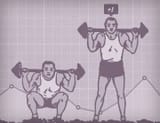
My one true layout
Recently I’ve been “evangelizing” Docker quite a bit among the Happy Cog developers. Sometimes that sounds like “zomg, Mark really loves Docker” and other times it’s closer to “omg, why is he over engineering this again.” What I’ve been working on, lately, is a way to use Docker containers to re-implement a more flexible version of Heroku. The end goal is a workflow that starts with a developer pushing code. That code, regardless of branch, is published to a unique URL that anyone can see, regardless of their setup or environment.








